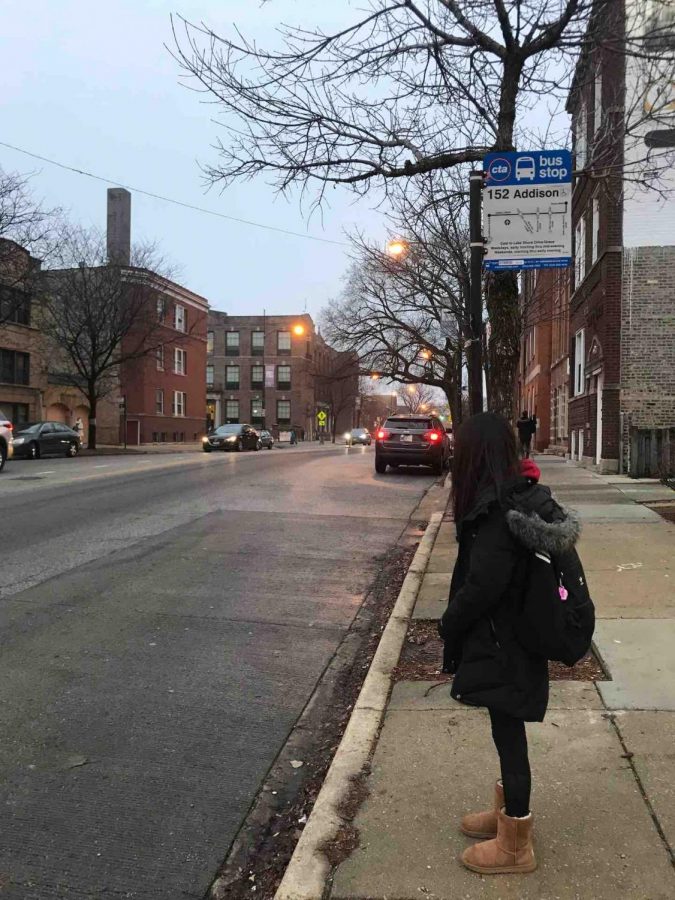Is Lane worth the commute?
After school, Kaylie Fang, Div. 250, boards the 152 Addison bus that takes her to the Red Line station. There are many students like Fang who have to take two or more methods of transportation. (Photo courtesy of Victor Mei)
As hundreds of people dash onto the train during the busy time of rush hour, scurrying to find their seats, Nia Muhammad, Div. 953, tries to mentally fight her way through the chaos.
After uncomfortably standing up for nearly an hour and a half in an attempt to escape the nastiness of whatever germs might lie on the seats, she lets out a sigh of relief when an automated voice announces that they’ve reached 95th. This is the last stop on the southbound Red Line train, but her journey isn’t over yet — she still has a long trek to the bus that will eventually take her home.
Lane admits students from all over Chicago, spanning from neighborhoods as close as Roscoe Village to neighborhoods as far as Morgan Park.
In a survey conducted by The Warrior that was released to students via the student news email from Dec. 7 to Dec. 14, more than half of the 200 respondents indicated they have a commute of an hour or more.
With Chicago’s selective enrollment process, every student from Chicago has an opportunity to attend Lane, no matter what neighborhood they live in.
For students whose neighborhood schools do not offer as many opportunities as schools like Lane, they can benefit from the chance of being exposed to more AP classes and extracurricular activities.
Even though students who live far away are able to attend Lane, a lot of these students have trouble maintaining a good attendance and academic record because of how long their commutes can be.
Long commutes can result in students being late to their first period classes and having little to no study time after school.
“When I would take the school bus instead of the CTA like I do now, I would always be late to my first period class,” Carolina Carlos, Div. 252 said. “Me never being there resulted in my grade diminishing very quickly.”
Students like Carlos who live over an hour and a half away often come to school late and are also susceptible to having more demerits based on tardiness than students who live closer.
According to Lane’s website, any student who is late to first period will receive one demerit, and any student with over five demerits will have to serve an after school or Saturday detention.
Students also run the risk of losing out on the chance to attend special events like I-Days, while seniors risk not being able to go to senior events, such as Octoberfest and even Prom.
This can be discouraging to students whose commute can make them late by uncontrollable circumstances.
“On a high traffic day when there are a lot of people on the train, or if the bus is late, that will stretch my travel time up to two hours,” Muhammad said.
Chicago’s public transportation system can be very unpredictable. As reported by the Chicago Tribune, popular transit lines like the Red and Blue lines are notoriously known for having major delays because of unplanned accidents or other occurrences such as unauthorized people on the train tracks, police activity, or sick passengers.
While waking up a little earlier may seem like a reasonable option, it’s hard for some students because they already wake up extremely early.
“I already wake up at five and I still don’t get to school on time, so I’m not waking up at four in the morning — it’s just not even worth it to me,” Muhammad said.
It’s even harder to participate in after school activities because of how long students are expected to stay.
“Normally I would get home around 5:30 if I left school immediately, but when I was doing rugby, practice would end at 5:30, so I wasn’t getting home until around 7:30, close to 8:00,” Muhammed said. “That made doing homework impossible.”
Carlos, who is currently in the school play, doesn’t get home until around 8 p.m..
“Let’s say I have three hours of homework a night, which I do on average,” Carlos said. “I stay up to 11:00 doing it until I really don’t have time to do anything else.”
Taking public transportation during late evening hours can also be intimidating for students like Carlos, especially during the fall and winter seasons when it starts to get dark earlier.
When taking the bus late at night, Carlos has to be exceptionally aware of her surroundings as she commutes to the South Side.
According to the American Academy of Sleep Medicine, lack of sleep can impair students’ ability to learn.
Kylie Fang, Div. 250, who lives in Chinatown, said her lack of sleep can sometimes result in her being exceedingly tired.
“Since I live far away and I get less hours of sleep, I have trouble focusing during classes,” Fang said. “I fall asleep in them.”
Having a lack of sleep can be difficult too, especially during test days and finals week.
“If I got to sleep at 12:00 or 1:00, I still have to wake up at 5:00. I’m still exhausted for the next day and around finals. It’s really hard,” Muhammad said.
Despite these commuting difficulties, Lane still appeals to most students. With over 4,000 students, Lane is still the largest selective enrollment high school in Chicago.
“I like all of the extra stuff that comes with Lane — you have clubs, I-Days and AP classes, which looks really nice on my college applications,” Muhammad said.
According to Niche.com, Lane is ranked number five for the most diverse public schools in Chicago. Lane also offers all 34 AP classes as well as 38 athletic clubs.
“I love Lane and the commute to me is worth it,” Fang said.
Your donations directly fund the Lane Tech student journalism program—covering essential costs like website hosting and technology not supported by our school or district. Your generosity empowers our student reporters to investigate, write, and publish impactful stories that matter to our school community.
This website is more than a publishing platform—it's an archive, a research tool, and a source of truth. Every dollar helps us preserve and grow this resource so future students can learn from and build on the work being done today.
Thank you for supporting the next generation of journalists at Lane Tech College Prep!
Leda Edwards is currently a Senior here at Lane tech. As a member of the OMEGA Historia concentration, she enjoys indulging in creative writing like...




